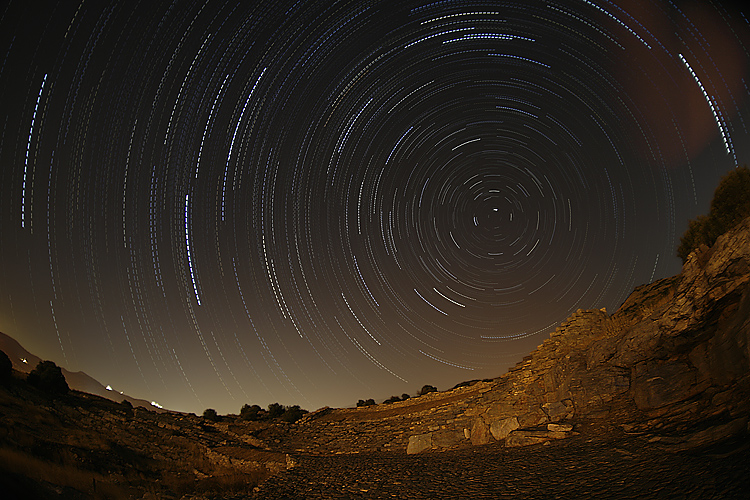
One of the most basic types of astrophotography and yet equally stunning is that involving star trails, particularly around the celestial poles
or immediately due east or west. In addition to capturing the motion of stars around the north pole which are circumpolar and, hence, never
rise or set, we also have the ability to capture seasonal constellations and stars in such photos, thus allowing for different opportunities
during different seasons. Star trail photos also provide direct evidence that our planet rotates and does so at a rate of 15° per hour.
Furthermore, by studying the arc for a particular star, especially as far away from the pole as possible, one can indirectly estimate the
length of the (total) exposure which often ranges from seven to eight hours in duration and is totally dependent on the end of
astronomical twilight one evening and its onset the following morning.
Many star photos are centered on Polaris, a double star system which represents our quickest means to locating the north celestial pole, for
it lies less than 1.0° from it, and is an excellent starting point for the polar alignment of a telescope (and finding your way home if you
are lost!). Due to the extended length of the typical exposures involved, the best film for such work is Kodak Elite Chrome (ISO 100) whose
reciprocity failure is nearly zero or Fujichrome Velvia and Provia (ISO 50 and 100) emulsions with equally impressive curves! With respect
to equipment, it is rudimentary, for a camera with extended exposure capibility is required along with a firm tripod and shutter release and
locking cable. It is also preferable that the camera used have a mechanical shutter so that battery consumption and power does not become an
issue during mid-exposure. The final requirement is a location with dark skies - the darker the better so that the trails and their colouration
will be as bright and contrasty as possible - with, preferably, an interesting foreground which can be used to enrich the final result.
Note: The Ancient Theatre at Thoricus is the oldest such theatre in mainland Greece and is dated 525-480 BC. Its
discovery and excavation in 1886 is credited to the archaeologist Samuel Walter Miller (1864-1949) who sought its excavation while on assignment
with the American School of Classical Studies in Athens. The theatre is well-preserved and atypical in shape, for it deviates from the typical
semi-circular formation by being elongated and measuring 55 meters for the cavea and 27 meters for the orchestra.
The multi-exposure sequence below was based on the end of astronomical twilight and its onset the following morning, for the sky is darkest
during this period. A slight delay following the end of astronomical twilight was strategically introduced so as to have the very young moon
low along the western horizon, thus providing a natural but dim source of ambient light for the illumination of the Tholos and the immediate
surroundings.
|
Proper Star Name: Polaris Bayer Letter: á Ursae Minoris Tycho Catalog: TYC 4628-237-1 SAO Catalog: SAO 308 Luminosity 2290 +/- 282 x Sun Distance: 431 +/- 26 light yrs RA / Dec: 02h 39m 31s / +89° 17' 39" B-V Color Index: +0.570 mag Magnitude: 1.98 |
 |
Date: August 20-21, 2009 23:40 - 01:30 UT+3 Location: Anc Theatre of Thoricus Laurio, Greece Equipment: Canon EOS 5D Mark I Zenitar MC 16mm/f2.8 Exposures: 029 min (29 x 1 min) (RGB) 005 min (05 x 1 min) (Dark) ISO 400 JPG Fine Image Format 4368x2912 Image Size Continuous Servo Mode Software: Digital Photo Pro V1.6.1.0 Photoshop CS2 Processing: Dark Frame Reduction Layers and Lighten Unsharp Masking Resampling JPG Compression |